Think you can’t bake artisan sourdough bread at home? Think again! Sourdough Bread: a Beginner’s guide is your go-to recipe resource for simple, easy sourdough bread without kneading. Make the dough in the morning or at night- it will come together in under 10 minutes.
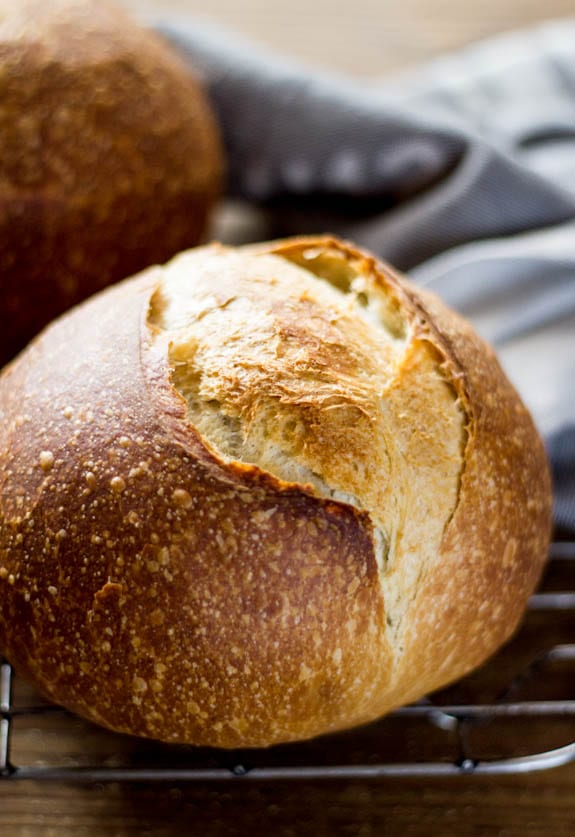
In 2013, my resolution was to bake more bread.
I researched, tested and baked countless loaves with both good and mixed results. My journey began with this no-knead artisan bread recipe and eventually, I worked my way up to the holy grail: Sourdough. My passion for creating easy sourdough bread recipes and preserving traditional culinary arts inspired my bestselling book Artisan Sourdough Made Simple which has connected me to like-minded bakers all over the world! Lucky me 😉
If you’re curious about sourdough bread (and don’t know where to begin), trust me, you’re in the right spot. My beginner sourdough bread recipe has been THE MOST popular recipe on my blog for over a decade and continues to earn millions of page views a month. Welcome to the journey!
What You’ll Learn
In this tutorial, you’ll learn how to make simple sourdough bread with step-by-step instructions and videos for guidance. There’s no kneading involved, and a bread machine or a stand mixer is not required. My sourdough bread recipe is perfect for beginners. I’ll explain a complex topic in simple terms without the stress! But before you dive in, here’s a secret: sourdough bread is more than just a recipe… it’s an understanding.
There are similar sourdough bread recipes out there and yet no two loaves look alike. The process is all about method, timing and personal touch. Use this tutorial as a guide and make your own adjustments as you go. Once you have a few loaves under your belt, the process will become an imminent rhythm, and in the end, you will have created your very own masterpiece that is the ultimate reward. Just don’t forget to eat your mistakes (might I suggest homemade sourdough breadcrumbs)?
Jump To
- Sourdough Bread Recipe
- Step by Step Instructions
- Sourdough Starter 101
- Sample Baking Schedule
- Sourdough FAQ
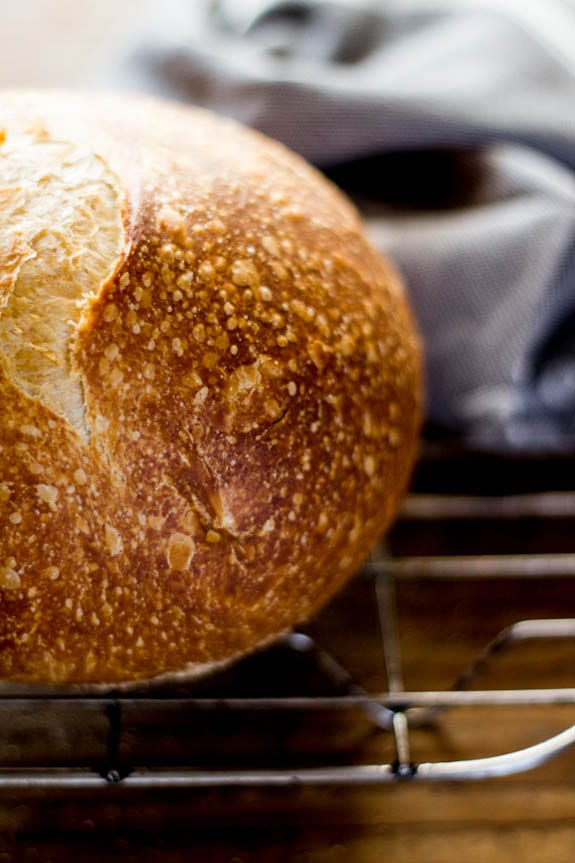
So, What is Sourdough?
In a nutshell, sourdough is slow-fermented bread.
It’s unique because it does not require commercial yeast in order to rise. Instead, sourdough bread is made with a live fermented culture a sourdough starter, which acts as a natural leavening agent.
Sourdough is known for its characteristic tangy flavor, chewy texture and crisp, crackly crust. From a health standpoint, it dominates when compared to supermarket loaves. The naturally occurring acids and long fermentation help to break down the gluten, making it more digestible and easy for the body to absorb. And it tastes darn good!
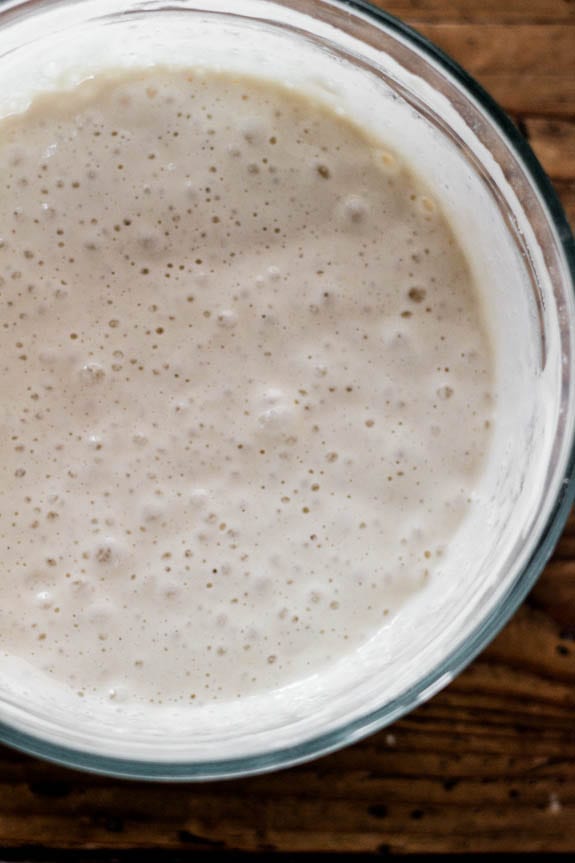
Sourdough Starter 101
Before you begin, you’ll need a sourdough starter.
Simply put: a sourdough starter is a live culture made from flour and water.
Once combined the mixture will begin to ferment, cultivating the naturally occurring wild yeasts and bacteria present within the mixture. A small portion of this culture is used make your bread dough rise.
But it doesn’t stop there.
Your starter must be kept alive with regular feedings of flour and water to maintain its strength for maximum rising power.
How to Feed your Sourdough Starter
Every baker has their own method, and with practice you’ll eventually develop your own routine.
Here’s my method: I pour off some of the culture (about half) and then feed what’s left in the jar with equal weights of flour and water. I whisk well with a fork until it’s lump-free. Then, I let it rest at room temperature or in a warm spot (75-80º F/ 24-26º C is ideal) until it becomes bubbly and active.
PS: I use this the jar for my sourdough starter and I LOVE it.
When is my Starter Ready To use?
Your stater is ready to use when it becomes bubbly and doubles in size.
This can take anywhere from 2-12 hours or more depending on temperature (the warmer the better) and the condition of your starter. Be patient!
Float Test: If you’re still unsure whether it’s ready to use drop a small amount, about 1 tsp, into a glass of water. Do this when the starter is a peak height before it collapses. If it floats to the top it’s ready to use. If it sinks, your starter should be fed again.
Where to Obtain a Sourdough Starter
All sourdough starters are different.
They can be made from scratch, purchased online, or if you’re lucky, someone will share a portion of their starter with you.
Starters range from thick to thin in texture and can be made with a variety of flours. I use two different starters; one is homemade and the other was a gift from my friend Celia. She dried a portion of her starter and mailed it all the way from Sydney, Australia.
How To Use A Starter
After you’ve fed your starter and it’s bubbly and active, pour the amount you need out of the jar to weigh or measure for your recipe. That’s it.
Then, don’t forget to feed what’s left in the jar with more flour and water to keep the process going.
Any leftover sourdough starter can be used to make sourdough discard recipes, even my homemade sourdough pasta.
Storage Options
If you only bake a few times a month, keep your starter in the fridge and feed it once a week. If you’re an avid baker, store your starter at room temperature and feed it at least once a day.
Looking for more info on sourdough starters? Check out Feeding Sourdough Starter: My Best Tips & Tricks & Sourdough Discard 101: Recipes & Faqs Answered.
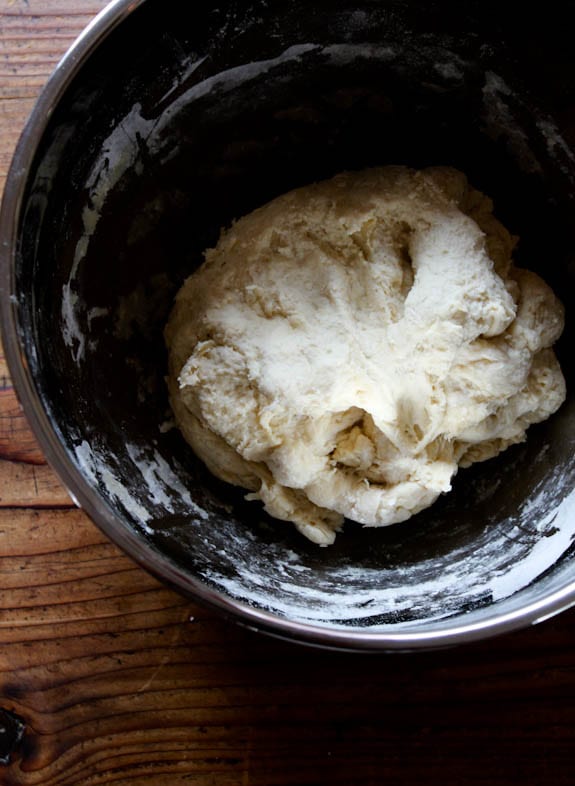
How to Make Sourdough Bread: Step-By-Step Guide
Step #1: Mix The Dough
Combine the following ingredients in a large bowl (I use a fork):
- 250 g water
- 150 g bubbly, active sourdough starter
- 25 g olive oil
Add:
- 500 g bread flour (such as King Arthur)
- 10 g fine sea salt
Squish the mixture together with your hands until the flour is fully absorbed. The dough will feel dry, rough and shaggy.
Cover the bowl with plastic wrap, reusable wax wrap, or a very damp kitchen towel and let rest or ‘autolyse’ for about 30 minutes. After the dough has rested, work it into a ball directly in the bowl (it doesn’t have look perfect).
TIP: For best results, weigh all of your ingredients with a digital kitchen scale. Measuring cups are not as accurate. Please visit Sourdough FAQ for more details.
What is Autolyse?
This is the first resting period right after you mix the dough.
It jumpstarts gluten development without kneading. Strong gluten = good bread.
For timing, autolyse can range anywhere from 15 minutes to 1 hour or more depending on the type of bread you’re making and your own personal baking schedule. A minimum of 30 minutes works best for this recipe. However, when time permits, I’ll let it go for an hour. The dough will become more soft and manageable to work with afterwards.
A Note on Salt: some bakers prefer to add salt only after autolyse because it might slow down the gluten development. I’ve followed this technique for years, but no longer do so. I prefer to mix everything all at once. It’s practical, effective and produces excellent loaves (plus, you won’t forget to add the salt later on!). I’ll leave the choice up to you.

Step #2: Bulk Rise
Now the dough is ready to rise.
Cover the bowl and let rise at room temperature, about 68-70 F.
How Long will it take?
The dough is ready when it has doubled in size and no longer looks dense.
This can take anywhere from 3-12 hours depending on your current room temperature, the potency of your sourdough starter and the specifics of your surrounding environment.
For example, in the summer the dough can take anywhere between 2-4 hours @ 85º F/ 29º C. In the winter, it will take longer about 10-12 hours @ 68º F/ 20º C. Temperature controls time.
And remember: because sourdough bread does not contain instant yeast it will take longer to rise. Watch the dough and not the clock. Be flexible.
Optional Step: Stretch and Fold the Dough
About 30 minutes into the bulk rise, you have the option to perform a series of ‘stretch & folds’ to strengthen the bread dough {click here for a step-by-step tutorial}. Although it’s not mandatory, this technique will add height and structure to the finished loaf and it’s fun to do.
Watch the video below!
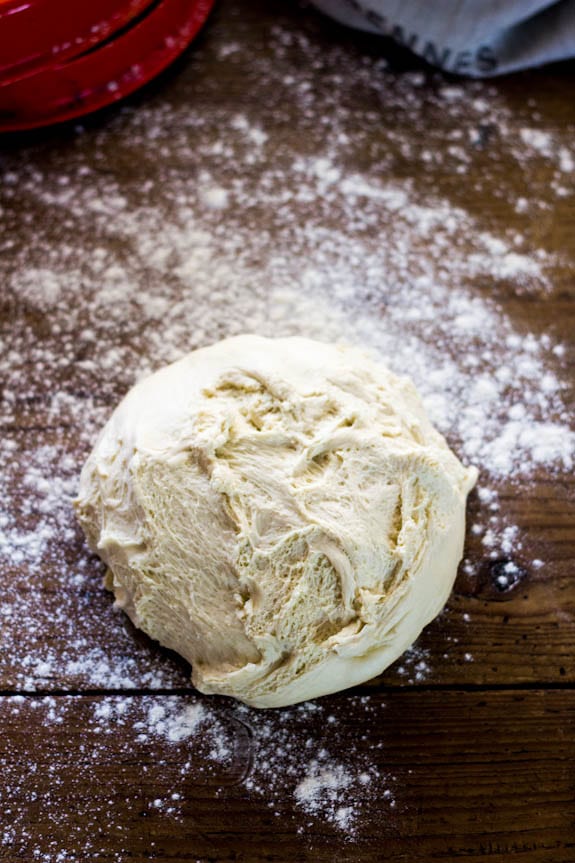
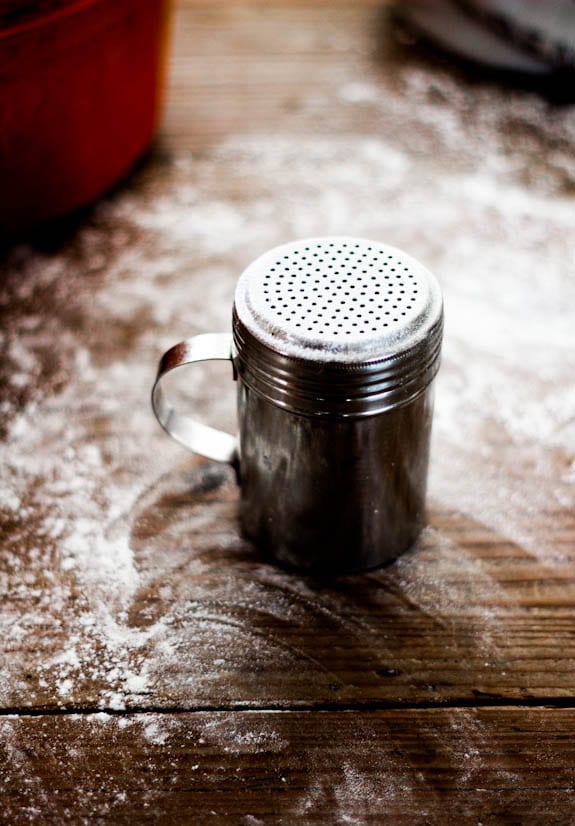
Step #3: Divide & Shape The Dough
Remove the dough onto a lightly floured surface.
Cut the dough in half to make 2 loaves, or leave it whole for a single loaf.
How to Shape a Round Sourdough Boule (Loaf)
Starting at the top, fold the dough over toward the center. Give it a slight turn, and then fold over the next section of dough. Repeat until you have come full circle. Or, use the envelope shaping technique outlined below.
Watch the video!
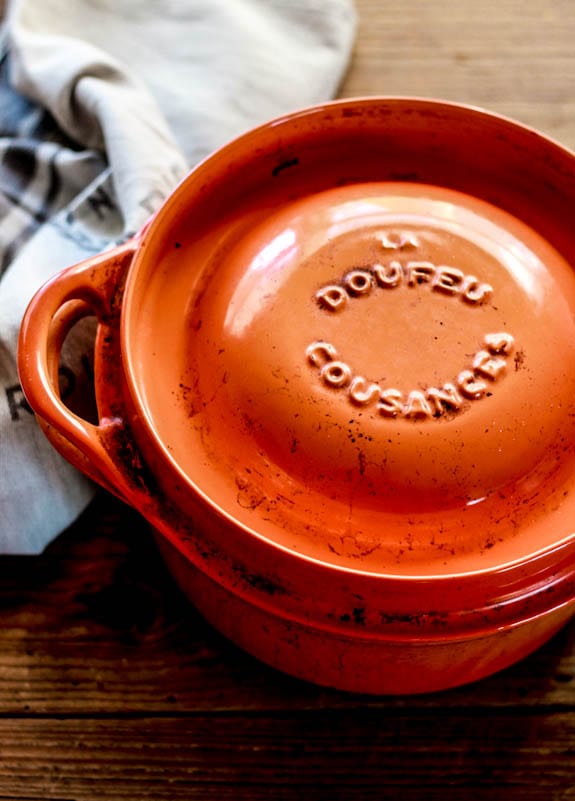
Step #4: Choose a Baking Pot
I bake my sourdough bread in a Dutch oven.
You can also try the Challenger Bread Pan, another vessel I use for baking, that can accommodate both round and oval shaped loaves.
The pot traps in heat and moisture which is essential to achieving artisan style bread at home.
Steam plays a key role in how the bread will open up or ‘bloom’ while baking and the Dutch oven helps to control this process.
You can use any oven safe pot that can heat up to 450º F/ 232º C (including the lid and handles).
TIP: In the past, I’ve tried baking on pizza stones and cookie trays with no luck. The crust would harden too quickly, forcing the bread to tear on the bottom and sides. I used various steaming methods to remedy this, however I found them to be extremely cumbersome and not realistic for everyday use. Nothing worked. The lack of moisture in my home oven was evident and using a pot for baking was the only practical solution.
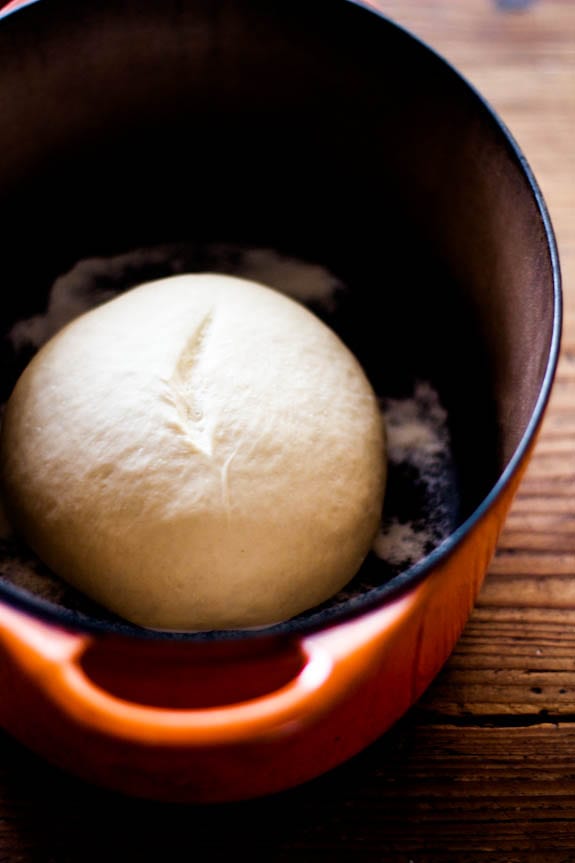
Step #5: Second Rise
After shaping the dough, it needs to rise again.
Generously coat the bottom of your Dutch oven with cornmeal (or line the bottom with non-stick parchment paper instead) and place the dough inside.
This time, the dough will rise for a shorter period about 30 minutes- 1 hour.
The dough is ready when it’s puffy and no longer dense. It does not need to double in size.
Preheat your oven to 450º F/ 232º C during the tail end of the second rise.
TIP: Instead of doing a free form second rise in the Dutch oven, use a cloth lined proofing basket or 8-inch bowl instead. Either option will contain the dough and hold its shape properly during the second rise.
Step #6: Score The Dough
After the second rise, and right before the dough goes into the oven, make a slash about 2-3 inches long down the center of the dough.
This allows the steam to escape and for the dough to expand during baking.
You can use a small serrated knife, paring knife or bread lame.
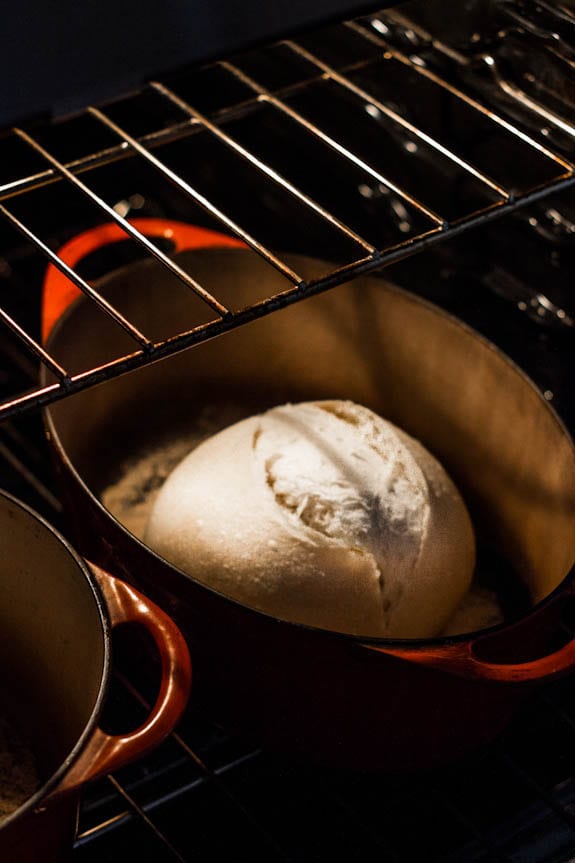
Step #7: Bake The Sourdough Bread
Place the lid on top of the pot and reduce the oven temperature to 400º F/ 204º C.
Bake on the center rack for 20 minutes.
When 20 minutes is up, remove the lid. Your bread will be pale and shiny like the picture above.
Continue to bake (uncovered) for an additional 40 minutes or until deep, golden brown. The internal temperature should read 205-210º F/ 96-98º C.
Cool on a wire rack for at least a 1 hour before slicing. Be patient!
If you cut into it too soon, the texture will be gummy…
TIP: During the last 10 minutes of baking, crack open the oven door (optional). This allows the moisture to escape, leaving your sourdough bread with a crisp crust. Alternatively, remove the bread from the pot and let it bake directly on the rack. The latter produces a more crisp crust.
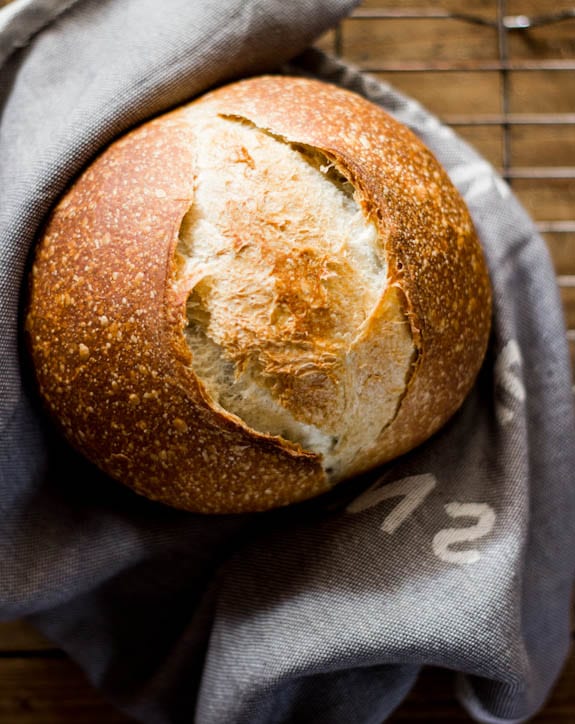
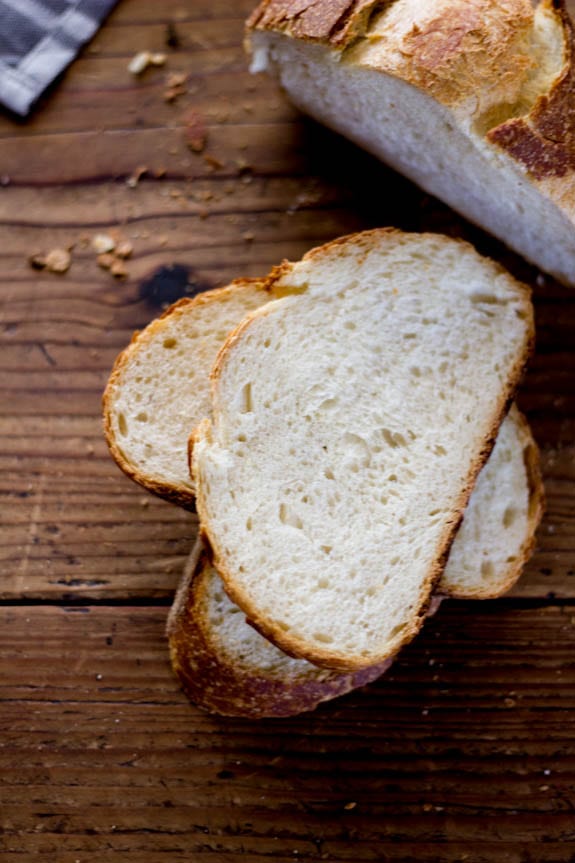
Additional Sourdough Recipes & Resources
Sourdough Starter:
- Beginner Sourdough Starter {Recipe}
- Feeding Sourdough Starter: My Best Tips & Tricks
- Sourdough Discard 101: Recipes & Faqs Answered
Sourdough Bread Recipes:
- Beginner’s Guide to Sourdough Focaccia Bread
- Best Sourdough Pizza Crust (No steel or stone!)
- Best Sourdough Pasta (1 hour or Overnight)
- Light Whole Wheat Sourdough
- Easy Sourdough Sandwich Bread
- Soft Sourdough Cinnamon Rolls
- Best Sourdough Pancakes
Sourdough Bread Tips & Techniques:
- How to Stretch and Fold Sourdough {Video}
- How to Shape a Round Sourdough Boule {Video}
- Why Won’t My Sourdough Bread Rise?
- Bread Flour vs. All Purpose Flour: What’s the Difference?
Sourdough Tools & Supplies:
Baking Schedule
- Friday Evening: Feed your starter, cover the jar, and leave it on the counter overnight. If you keep your starter in the fridge, it might need two feedings to perk back up (feed it in the morning & in the evening).
- Saturday Morning: Check your starter: if it’s alive and bubbling, you can make the dough to rise during the day. Or, feed it again in the afternoon to make the dough in the evening for an overnight rise. Remember to use the float test mentioned above to make sure your starter is ready to use.
- Saturday Morning/Evening (or whenever your starter is ready): Make the dough. Leave on the counter to bulk rise at room temperature. In the summer, if your dough rises quickly and you’re not ready to bake, cover the whole bowl with lightly oiled wrap and chill until ready to use.
- Sunday Morning: cut and shape the dough. Place in Dutch oven for second rise. Slash. Bake. Cool. Eat.
Sourdough Bread Recipe
Print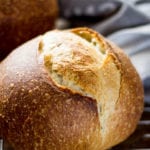
Sourdough Bread: A Beginner’s Guide
- Prep Time: 13 hours
- Cook Time: 1 hour
- Total Time: 14 hours
- Yield: 1 loaf
- Category: Sourdough Bread Recipes
- Method: Oven-Baked
- Cuisine: American
- Diet: Vegan
Description
This beginner sourdough recipe is perfect for bakers looking to jump right in! It’s is a low-hydration dough, meaning it will yield a ‘tight’ crumb (small holes). It is great for sandwiches and toast.
Ingredients
- 150g/ 5.35 oz bubbly, active sourdough starter
- 250g/ 8.80 oz warm water, preferably filtered*
- 25g/ .90 oz olive oil
- 500g/ 17.65 oz bread flour (not all purpose flour)
- 10g/ .4 oz fine sea salt
- fine ground cornmeal, for dusting
*For a more soft and pliable dough, you can increase the water up to 300 g- 325 g total. Please use a cloth lined bowl (instead of the Dutch oven for the second rise).
**You will need a 5 1/2 or 6 quart Dutch oven for baking
***This recipe was tested with King Arthur Bread Flour, Gold Medal Bread Flour, Pillsbury Bread Flour
Instructions
Make the Dough
Whisk the starter, water, and olive oil in a large bowl. Add the flour and salt. Squish everything together with your hands until all of the flour is absorbed. The dough will be dry and shaggy. Cover the bowl with plastic wrap, reusable wrap or a clean, very damp kitchen towel. Let rest (autolyse) for 30 minutes or up to 1 hour, if preferred.
After the dough has rested, work the dough in the bowl into a rough ball, about 15 seconds.
Bulk Rise
Now the dough needs to rise.
Cover the bowl with wrap or a very damp kitchen cloth. Let rest in a warm spot to rise. The dough is ready when it no longer looks dense and has doubled in size. This can take anywhere from 3-12 hours depending on the temperature of your ingredients, the potency of your starter and surrounding environment. For example, in the summer rise times can take anywhere between 2-4 hours @ 85º F/ 29º C whereas in the winter, the dough will take about 10-12 hours @ 68º F/ 20º C.
Optional Step: Stretch & Fold the Dough
During bulk rise, you have the option to perform a series of ‘stretch & folds’ to strengthen the dough. Start 30 minutes into the bulk rise. Gather a portion of the dough, stretch it upwards and then fold it over itself. Rotate the bowl ¼ turn and repeat this process until you have come full circle to complete 1 set. Do this once or twice spaced about an hour apart. Although this step is not mandatory, it will increase the total volume and height of your bread. Click here for a step-by-step video tutorial.
Cut & Shape the Dough
Divide your work surface in half; lightly flour one side (for cutting) and leave the other half clean (for shaping).
Remove the dough from the bowl, and place onto the floured section so that it does not stick. You do not need to ‘punch down’ the dough; it will gently deflate as you fold and shape it.
Cut the dough in half to make 2 loaves, or leave it whole for a single loaf.
To shape, use a bench scraper to move your dough to the non-floured section (if there is any flour present, it will be difficult to shape- brush away any excess). Starting at the top, fold the dough over toward the center. Give it a slight turn, and then fold over the next section of dough. Repeat until you have come full circle.
Then flip the dough over and place it seam side down. Using your hands, gently cup the sides of the dough and rotate it, using quarter turns in a circular motion. You can also pull it towards you to even out the shape. Repeat this process until you are happy with its appearance. *See note below.
Second Rise
Now the dough needs to rise again, but for a shorter period of time.
Coat the bottom of your Dutch oven with cornmeal. Alternatively, use parchment paper to prevent sticking (this is what I do, now). Place the dough inside for a second shorter rise, about 30 minutes to 1 hour and cover with the lid of the pot or a very damp cloth. The dough ready when it is slightly puffy but not double in size.
Preheat your oven to 450º F/ 232º C towards the tail end of the second rise.
Score the Dough
Right before your bread goes into the oven, make a shallow slash about 2-3 inches long (or more) in the center of the dough. Use a bread lame, sharp pairing or a small serrated steak knife. The cut should be about 1/4-inch deep.
Bake the Dough
Place the bread into the oven on the center rack (lid on) and reduce the temperature to 400° F/ 204° C. Bake for 20 minutes. Remove the lid, and continue to bake (uncovered) for an additional 40 minutes or until deep, golden brown. Keep in mind that all ovens are different; you might have to make minimal adjustments to these temperatures.
You can also take the internal temperature of your bread to double check that it is done. For sourdough, it should read about 205-210º F/ 96-98º C.
Remove the bread from the oven, and cool on a wire rack for at least an hour before slicing. Don’t cut too soon or else the inside will have a gummy texture!
Notes
When shaping, the idea is for the dough to catch enough surface tension on a non-floured area in order to create a tight ball. If there is flour present, it will slide around… and drive you nuts.
Sourdough FAQ
1.) I only have all purpose flour. Can I still make this recipe?
For best results, use bread flour for this dough. If you only have all purpose try my Artisan Sourdough with All Purpose Flour instead.
2.) Can I add whole wheat flour to this recipe?
You can, but I wouldn’t. The dough will be too dry and dense without adjusting the water quantity. Try my Light Whole Wheat Sourdough for more whole grain goodness.
3.) Your beginner recipe here uses 150g of sourdough starter. The Everyday Sourdough in your book uses only 50g. What’s the difference? And why?
- When I first learned how to bake sourdough bread, I used 150g of starter. Overtime, it was too much to maintain (especially when doubling and tripling recipes). So, I scaled down. That’s why most recipes in my book Artisan Sourdough Made Simple include 50 g of starter instead. One amount is neither right or wrong; it’s just a matter of preference.
4.) What’s the purpose of olive oil in this recipe?
Adding olive oil to sourdough was the method I followed when I first learned how to bake. The natural fat emulsifies the dough and makes a plush crumb.
5.) Why do some of your recipes call for the second rise in a Dutch Oven? And others in a cloth- lined bowl?
The freeform Dutch oven second rise will only work with dry, low hydration doughs (like this one) because it will not spread out too much. On the flip side, when working with wet, high hydration doughs you’ll need to use a cloth-lined bowl sprinkled with flour to holds it shape. Otherwise, it will spread.
6.) Why don’t you preheat your Dutch oven before baking?
Because this recipe follows a freeform second rise directly in the baking pot, it cannot be preheated beforehand. The dough will begin to cook before going into the oven!
However, if you are doing the second rise in a cloth-lined bowl as mentioned in question #5 above, you can preheat the pot if you’d like. When bread dough is placed into a hot pot it begins to expand instantly which is great for the overall shape and structure of the bread. And in fact, I use to follow this technique when I first started baking. But overtime, I found the preheat to be too cumbersome for small kitchens with little kids running around. Plus, I kept burning my wrists. Long story short: you can achieve comparable results without the preheat. The choice is up to you.
7.) Can I halve the dough to bake 2 loaves? If so, what will that do to the baking time?
Yes, you can definitely halve this recipe. Bake for 20 minutes (lid on) and 30 minutes (lid off). Check at the 45 minute mark.
8.) If I halve the recipe, where should I store the second dough if I’m not baking at the same time?
Store the second dough in the fridge until ready to bake. Place the dough in a cloth-lined floured bowl (seam side down) and use the cloth overhang to cover it. If the dough is in the fridge for longer than 1 hour, rest at room temperature while the oven heats up.
9.) How do I get the dough out of the cloth-lined floured bowl?
Open up the cloth overhang to reveal the dough in the bowl. Place a piece of parchment paper on top of the dough. Flip the bowl over. Remove the bowl and cloth. The dough is now smooth side up and ready to be scored.
10.) Can I have the measurements for this recipe in cups, please?
- 3/4 cup bubbly, active starter
- 1 cup + 1 tbsp warm water
- 2 tbsp olive oil
- 4 cups bread flour
- 1 1/2 tsp fine sea salt
NOTE: Weight and volume measurements are not equivalent, only approximate. I strongly recommend weighing your ingredients instead. With that said however, I understand the convenience of measuring cups. For best results, please aerate the flour first (I fluff it with a fork directly in the bag), then lightly spoon and level it into the cup. Too much flour will make the bread dense. If your sourdough starter is very bubbly, the volume amount might be off. If necessary, add up to 1 cup as needed. Finally: the water can be increased up to approximately 1 1/3 cups, for a more soft and pliable dough.
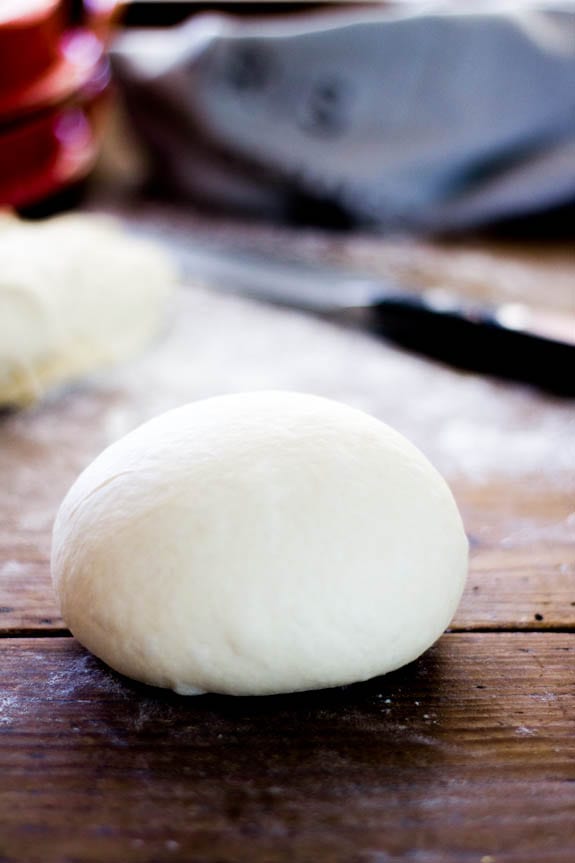
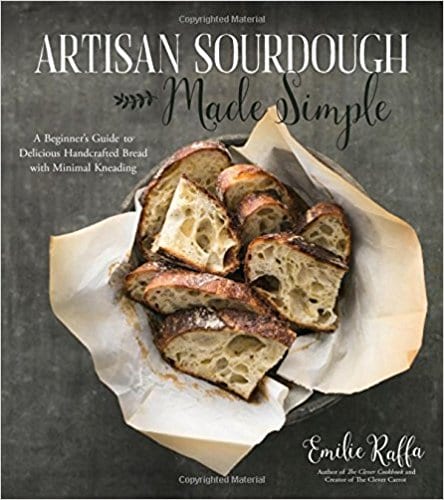


Comments
Linda J. Anderson says
Double batch on the Autolyse step right now. It has been a while since I have made sourdough bread and this was very helpful. My starter is more than 50 years old, handed lovingly to me from my friend. It has the greatest amount of energy in it. Looking forward to sharing the extra loaves.
Emilie Raffa says
Wow! 50 years old, that’s incredible. The energy must be incredible, that’s for sure. Thank you for sharing Linda :)
이동주 says
What is the name of this bread?
Nic says
Sour dough bread
Scarlett says
Have you ever used a 1 for 1 gluten free flour recipe??
Emilie Raffa says
Hi Scarlett. Great question. I haven’t tried a 1:1 GF flour with this recipe (yet). However, King Arthur flour just came out with a 1:1 GF bread flour, which I haven’t tried, but I’m curious about. It’s suitable for sourdough.
Violet Pelaez says
Good makes it easier.
Hettie says
Thanks for helping me to finally crack how to make sourdough bread. I found that by feeding the starter each day at 8 in the morning and again at 8 in the evening I had a strong starter bubbling away nicely by day 7. The bread is delicious and has a lovely texture. Thanks again!
Lynette Hansen says
This recipe is my go to and inspired me to buy your cookbook, which is beautiful. When I use less starter, the 50 grams, my dough is crazy sticky compared to this recipe. Any advice?
Mike says
Totally new to the whole world of sourdough. I got to talking with a friend who does a lot of homesteading and he gave me a start of his sourdough. Your little blog here is fantastic. It helped me learn to feed my sourdough and build enough confidence to finally make a loaf today!! I must say it turned out fantastic! Way better than I ever thought it would!! Nice Crispy crust and soft inside with all kinds of little air pockets! And the flavor is just amazing! Thank you so much! I’m glad I found this page
Vicki says
A newbie and complete rookie at sourdough baking.
My first ever attempt. It was clear that in my enthusiasm, I hadn’t allowed enough time for the starter to grow, even though it floated in water. The dough didn’t rise much, was sticky and hard to score. Thought it was a failure but cooked it anyway.
It was a HUGE hit with my hubby! So now I’m excited to make the next loaf!
James says
This recipe, as is, seems like pretty low hydration (57%). Does it come out better to use closer to 70% hydration?
Chandra says
Never made bread in my life!! After retirement, living in Italy for several years , eating fresh made wholesome bread was easy .
My neighbor welcomed me with a loaf of freshly baked bread , bottle of 100g starter and your sourdough recipe .
I never looked back , for the past 8 years I have been baking with your recipe and it has never failed me .
The perfect recipe!! Thank you
Keith Meaden says
I’ve tried sourdough starters and bread for several years now but this is the best bread I have ever made. Can’t stop me making bread now.
Mr G says
I tried this recipe in my new bread maker which has a sourdough programme. I’d made my own starter previously. It came out perfectly I’m amazed to say, no big air bubble holes so perfect for toast and sandwiches, which is exactly what I wanted. Put all the ingredients in, pressed start and five hours later a perfect sourdough loaf without any effort, I’m very happy!
Dave Blazer says
I tried your sourdough sandwich bread recipe and it came out perfectly! I used 100g starter and 255g water, preheated to 500ºf, and baked at 375ºF to 210ºF internally.
I haven’t made a loaf of bread for 40+ years.
I have a question on the simple boule recipe, can I use my mixer and dough hook and just follow the rest of it, or are adjustments necessary? Thanks!
Kat says
About to take my first loaf out of the oven. Everything looks and smells great but my dough was somewhat sticky when doing the final shaping. Any idea why that could have happened?
Debra says
I am new to this and following your starter method. At days 4,5 and 6 you say continue to feed but there is a comment about feeding after the starter falls. I am at 24 hours and my starter has almost risen twice as much in volume but has not fallen yet….Do I wait to feed or feed at the 24 hr schedule?
Cherise Hoak says
Yes! I just ordered your book too. Still trying to perfect a small loaf. Not giving up!
steve dorman says
I just bought your book but it hasn’t arrived yet. I also am waiting on a zitisushi bread machine. My question is can I just use the receipe in the instruction with the amount (60g of starter to do the job) or do I need to do something else for this to work. Thanks Steve Dorman.
Yun says
This is such an easy recipe and amazing results. So tasty. On my third batch. Just also made the cornbread and blueberry muffins today. Thanks for the recipes and detailed steps.
Laura Jones says
Hi there! Is it possible to add some mix-ins, like fresh herbs, into this recipe? If so, which stage would I add them?
Charlotte Goertzen says
Thank you very much, really enjoyed this article!
Gina says
I’m just wondering, during stretch snd folds, why my dough never comes out as stretchy and smooth and it looks on your video technique. It’s rather tough to pull and tough at and then hold over. Should I add more water ?? I use a Canadian Costco brand bread flour named creative bakers.
Brandon P. says
This recipe has been great. I am now on my tenth one and they are getting better. The Dutch oven with cornmeal is definitely the way to go. The better your starter is, the better your bread will be.
Mark says
This recipe gives me perfect results every time! I let the dough autolyse for a full hour, then stretch the dough every 1/2 hour, for the first 2 hours (4 times total. It’s amazing how the stretching transforms the dough from a sticky mess, to a perfect loaf!
CraftyTrebleChef says
Yes! That first blast of high heat helps to make the crust crispy. It helps with steam formation, but is too hot to cook the bread properly. Hope this helps!
Amy says
I started making this recipe with all purpose flour before I realized it specifically said not to. The dough is on the bulk rise phase of the recipe. What will happen to the loaf if I used the wrong type of flour?
Selma says
Honestly, it will still be vary tasty. I always make it with all purpose
Mackenzie says
This has been my first time making sourdough! I followed your instructions for the starter and the loaf, and it turned out great! I’m looking forward to trying your other recipes. Thank you for making them approachable for a beginner like me!
Monica Desai says
Really easy to follow recipe with consistently good results. I added sliced Kalamata olives and fresh rosemary to one loaf and it tasted delicious.
Kirsten Mitchell says
I’ve been baking with sourdough since 2020, and your book has taken me to a whole new level! I love your methods. But i want to tell you about my starter, Her Royal Ryeness. She has been fed almost exclusively with rye flour since her inception sometime in summer 2020. I never have discard starter, unless i make extra on purpose because i want to bake with it. I don’t have to start feeding several days in advance. On baking day, if i’ve used up most of her, i just scrape up what’s left in the jar, add 1/4 cup each water and rye flour, and put her back in the fridge. If i bake again within 4 or 5 days and it’s a 50g starter recipe, she’s all ready. If she seems a little sluggish i’ll let her sit on the counter for an hour or so. If i need more starter than that for a recipe, i’ll feed her and she’s ready in a few hours. I’ve neglected her for weeks (maybe months!) at a time, and let her dry out in the fridge (I cover the jar with a square of clean cloth and a rubber band.) When I’m ready to bake again, I just feed her, leave her on the counter, and in a few hours she’s ready to go. Ryeness is really the most amazing starter and i love her! Combined with your recipes and methods we are truly on top of our game.
Chanel says
How big of a dutch oven would we need to bake sourdough in?
Theresa Amy says
Excellent recipe. Easy to follow and lots of helpful hints!
Donna says
I have always used Ice cubes when baking with the lid in my other sourdough recipes , can I do this without compromising the beautiful loaf? I was wondering how to get the crust more crispy?
Your recipe is so user friendly and with 7 kids I appreciate that so much! Thank you so much Emilie! I will never go with any other recipe than this!
Donna says
Seriously, you are my new Foodie Hero!!!! Love this recipe and your book!!!!
Julia Stein says
I have made this recipe and bought your sourdough book, I noticed the recipe’s are different for the everyday sourdough. Which would be best ? The amount difference of starter is 100gs.
Sav says
Hi emilie! Ive been working on my starter and I’m close to being ready to begin my first sourdough bread attempt! You mention two tempteratires for baking in this, what is the purpose of the 450 degree, when we we bake at 400? I’m confused, do we put the dough in at 450 and let it cool down to 400 while baking?
Tim D. says
I made this bread yesterday and it’s amazing! I had friends over and it was a hit! Thank you!
Lili says
Hello! Thanks for your great recipe! My question is can I keep my dough in the fridge after the first bulk for additional fermentation as some recipes suggest? And then do the second shorter bulk in the DO prior to baking. Thanks much!
Kim Goldfeder Clarke says
I tried this recipe and it came out beautifully! Thank you for such clear and concise directions. Can’t wait to try some of your other recipes!
Marinda Furstenburg says
Good Day
Can I bake the sour dough in a gas stove?
Regards
Marinda
Mariya says
Hello, I tried baking this bread and I love it. Could you share the calories per 100 g of baked product, please?
Emilie Raffa says
Hi Mariya! So glad you liked it. Unfortunately, I do not have the nutrition info available. And online calculator would be helpful :)
Amber says
Hello! Am I able to leave out for about 5 hours on the second rise or is that too long? Should it go in the fridge or will it be okay just out on counter in a 73 degree home environment? Just trying to see how this will work with my schedule. :) Thank You! Looking forward to this recipe!
Emilie Raffa says
Hi Amber! In most cases, 5 hours would be too long for the second rise at room temperature (especially if it’s warm- it will over proof). I would put it in the fridge for best results.
Amanda says
I want to try to recipe but would I be able to start the bulk rise today then refrigerate after a few hours when it has doubled and bake the following day? My house is pretty warm on the east coast in July and I did this method with your sourdough bagels and they worked great!
Thank you!
Emilie Raffa says
Hi Amanda! Absolutely. You can chill the dough at anytime during the bulk rise to suit your schedule. Then continue when you’re ready. It’s flexible! PS: so glad you liked the bagels. They are some of my favorite sourdough things to bake :)
Katie M says
Love this recipe! A friend gave me some of her starter and her recipe but it was always hard to work with and was gummy and flat. Every time I used this recipe I had a great tasting loaf that rose well and was the perfect texture. I love to use it for sandwich bread, but I would prefer a batard/oval shape. When I’ve tried that shaping on my own the dough(because it’s more dry I think) was hard to form into the batard shape and the loaf often plit along the seam on the bottom. Do you have suggestions for shaping it into a more oval shape better for toast and sandwiches? Additionally, I’ve always scored it deep, even on rounds, but usually get a crack in the bread elsewhere along a seam or something, any tip for that too?
Emilie Raffa says
Hi Katie! FANTASTIC! Quick question to clarify: did you bake your oval/batard in a loaf pan to create sandwich bread? Or did you do use a baking pot? Thnaks!
Katie M says
I shaped it into a batard shape (followed a video but my dough was not as flexible as those in the videos) but then then it rise in the Dutch oven, not a batard/oval basket.
LA says
Attempting this recipe again. First time bread/sourdough baker & loving it 😍
Emilie Raffa says
Wonderful! I hope you are enjoying the process!
Alexis says
Can this be doubled??
Emilie Raffa says
Yes. You can double the recipe and rise the dough in a large, hi-sided dough tub with lid. Or, make (2) separate batches and rise in (2) separate bowls.
Nancy King says
Such great and easy instructions. Inspires confidence and it all works!
Emilie Raffa says
This is so great to hear Nancy, thank you!
Susan says
Emilie, I have your book Artisan Sourdough and have baked the Everyday Sourdough, High Hydration Sourdough and the Walnut Date Orange Loaf. I bake the bread in a Tramontina Cast Iron Dutch Oven pan using your recommended temp (450) and times (20 minutes covered, 30 minutes uncovered) Everything so far has burned. Always the bottom crust is black. I shortened the time by 10 minutes and the dough came out raw in the middle. What am J doing wrong?
Charlotte says
Hi, the recipe says to turn the temp down to 400f when you put the bread in, not leave it at 450 during baking! Hope that helps. :)
Emilie Raffa says
Hi Susan! What Charlotte recommended below is correct: to prevent burning, lower the baking temp as indicated in the specific recipe. Also, consider using an oven thermometer for accuracy. My oven runs hot in some spots and my thermometer regulates this. The pot you are using is fine. Oftentimes, I suggest placing a baking sheet on the rack directly below the pot (not underneath) to shield the heat from the bottom up.
Karissa Brandhagen says
Can you half this recipe? It’s such a big loaf for two people.
Shane braddick says
Shane braddick says this is great sourdough tips and recipes, thank you!
Emilie Raffa says
Thank you so much Shane!
Carol says
Just tasted a slice of my first ever sourdough bread – delicious! Thank you for the carefully written recipe – you’re making us all into star bakers :-) I fell upon sourdough baking a couple weeks ago as a local Italian restaurant gives away sourdough starter to patrons if they request some (at no charge!). The “mama starter” is 9 yrs old and my “baby starter” has behaved beautifully after every feed. I’m a complete newbie to this and am so delighted that the loaf turned out perfectly. My chef son immediately squeezed it out of the oven and said “It sounds exactly perfect. That’s an excellent loaf mom”. Apparently the bread should crackle when you give it a gentle squeeze. Who knew?!
Emilie Raffa says
Carol, thank you so much! What a kind note! It’s amazing your local restaurant shares their sourdough starter with guests. That’s the whole idea. To keep the love going. Love it. And receiving a star-rated approval from your son is absolutely priceless. They are the best (and most honest) critics.
Julia Stein says
I’ve tried this recipe 6 times, and bought your book. However- my dough always seems wet even at the recommended hydration. I’m not sure if it’s over proofing? Whenever I shape for second rise it never gives me a perfect ball.
Daisy says
Hi! Wondering if you can help!
My sourdough seems to be rising outwards rather than upwards and doesn’t gain much height during the baking progress. The bread itself isn’t dense and rises well during proving. Any advice?